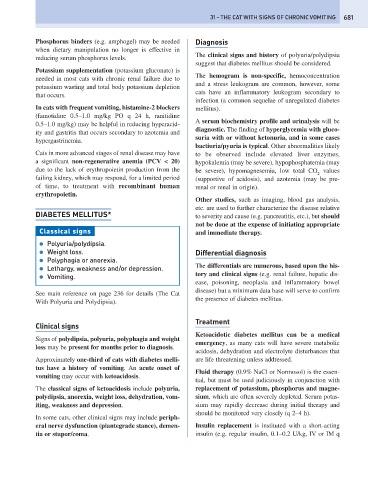Page 689 - Problem-Based Feline Medicine
P. 689
31 – THE CAT WITH SIGNS OF CHRONIC VOMITING 681
Phosphorus binders (e.g. amphogel) may be needed Diagnosis
when dietary manipulation no longer is effective in
The clinical signs and history of polyuria/polydipsia
reducing serum phosphorus levels.
suggest that diabetes mellitus should be considered.
Potassium supplementation (potassium gluconate) is
The hemogram is non-specific, hemoconcentration
needed in most cats with chronic renal failure due to
and a stress leukogram are common, however, some
potassium wasting and total body potassium depletion
cats have an inflammatory leukogram secondary to
that occurs.
infection (a common sequelae of unregulated diabetes
In cats with frequent vomiting, histamine-2 blockers mellitus).
(famotidine 0.5–1.0 mg/kg PO q 24 h, ranitidine
A serum biochemistry profile and urinalysis will be
0.5–1.0 mg/kg) may be helpful in reducing hyperacid-
diagnostic. The finding of hyperglycemia with gluco-
ity and gastritis that occurs secondary to azotemia and
suria with or without ketonuria, and in some cases
hypergastrinemia.
bactiuria/pyuria is typical. Other abnormalities likely
Cats in more advanced stages of renal disease may have to be observed include elevated liver enzymes,
a significant non-regenerative anemia (PCV < 20) hypokalemia (may be severe), hypophosphatemia (may
due to the lack of erythropoietin production from the be severe), hypomagnesemia, low total CO values
2
failing kidney, which may respond, for a limited period (supportive of acidosis), and azotemia (may be pre-
of time, to treatment with recombinant human renal or renal in origin).
erythropoietin.
Other studies, such as imaging, blood gas analysis,
etc. are used to further characterize the disease relative
DIABETES MELLITUS* to severity and cause (e.g. pancreatitis, etc.), but should
not be done at the expense of initiating appropriate
Classical signs and immediate therapy.
● Polyuria/polydipsia.
● Weight loss. Differential diagnosis
● Polyphagia or anorexia.
The differentials are numerous, based upon the his-
● Lethargy, weakness and/or depression.
tory and clinical signs (e.g. renal failure, hepatic dis-
● Vomiting.
ease, poisoning, neoplasia and inflammatory bowel
disease) but a minimum data base will serve to confirm
See main reference on page 236 for details (The Cat
the presence of diabetes mellitus.
With Polyuria and Polydipsia).
Treatment
Clinical signs
Ketoacidotic diabetes mellitus can be a medical
Signs of polydipsia, polyuria, polyphagia and weight
emergency, as many cats will have severe metabolic
loss may be present for months prior to diagnosis.
acidosis, dehydration and electrolyte disturbances that
Approximately one-third of cats with diabetes melli- are life threatening unless addressed.
tus have a history of vomiting. An acute onset of
Fluid therapy (0.9% NaCl or Normosol) is the essen-
vomiting may occur with ketoacidosis.
tial, but must be used judiciously in conjunction with
The classical signs of ketoacidosis include polyuria, replacement of potassium, phosphorus and magne-
polydipsia, anorexia, weight loss, dehydration, vom- sium, which are often severely depleted. Serum potas-
iting, weakness and depression. sium may rapidly decrease during initial therapy and
should be monitored very closely (q 2–4 h).
In some cats, other clinical signs may include periph-
eral nerve dysfunction (plantegrade stance), demen- Insulin replacement is instituted with a short-acting
tia or stupor/coma. insulin (e.g. regular insulin, 0.1–0.2 U/kg, IV or IM q

